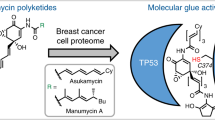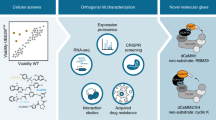Abstract
Nimbolide, a terpenoid natural product derived from the Neem tree, impairs cancer pathogenicity; however, the direct targets and mechanisms by which nimbolide exerts its effects are poorly understood. Here, we used activity-based protein profiling (ABPP) chemoproteomic platforms to discover that nimbolide reacts with a novel functional cysteine crucial for substrate recognition in the E3 ubiquitin ligase RNF114. Nimbolide impairs breast cancer cell proliferation in-part by disrupting RNF114-substrate recognition, leading to inhibition of ubiquitination and degradation of tumor suppressors such as p21, resulting in their rapid stabilization. We further demonstrate that nimbolide can be harnessed to recruit RNF114 as an E3 ligase in targeted protein degradation applications and show that synthetically simpler scaffolds are also capable of accessing this unique reactive site. Our study highlights the use of ABPP platforms in uncovering unique druggable modalities accessed by natural products for cancer therapy and targeted protein degradation applications.
This is a preview of subscription content, access via your institution
Access options
Access Nature and 54 other Nature Portfolio journals
Get Nature+, our best-value online-access subscription
$29.99 / 30 days
cancel any time
Subscribe to this journal
Receive 12 print issues and online access
$259.00 per year
only $21.58 per issue
Buy this article
- Purchase on Springer Link
- Instant access to full article PDF
Prices may be subject to local taxes which are calculated during checkout





Similar content being viewed by others
Data availability
The datasets generated during and/or analyzed during the current study are available from the corresponding author on reasonable request.
References
Nomura, D. K. & Maimone, T. J. Target identification of bioactive covalently acting natural products. Curr. Top. Microbiol. Immunol. 420, 351–374 (2018).
Drahl, C., Cravatt, B. F. & Sorensen, E. J. Protein-reactive natural products. Angew. Chem. Int. Ed Engl. 44, 5788–5809 (2005).
Liu, J. et al. Calcineurin is a common target of cyclophilin-cyclosporin A and FKBP-FK506 complexes. Cell 66, 807–815 (1991).
Cohen, E., Quistad, G. B. & Casida, J. E. Cytotoxicity of nimbolide, epoxyazadiradione and other limonoids from neem insecticide. Life Sci. 58, 1075–1081 (1996).
Bodduluru, L. N., Kasala, E. R., Thota, N., Barua, C. C. & Sistla, R. Chemopreventive and therapeutic effects of nimbolide in cancer: the underlying mechanisms. Toxicol. In Vitro 28, 1026–1035 (2014).
Subramani, R. et al. Nimbolide inhibits pancreatic cancer growth and metastasis through ROS-mediated apoptosis and inhibition of epithelial-to-mesenchymal transition. Sci. Rep. 6, 19819 (2016).
Hao, F., Kumar, S., Yadav, N. & Chandra, D. Neem components as potential agents for cancer prevention and treatment. Biochim. Biophys. Acta 1846, 247–257 (2014).
Gupta, S. C., Prasad, S., Tyagi, A. K., Kunnumakkara, A. B. & Aggarwal, B. B. Neem (Azadirachta indica): an Indian traditional panacea with modern molecular basis. Phytomedicine 34, 14–20 (2017).
Burslem, G. M. & Crews, C. M. Small-molecule modulation of protein homeostasis. Chem. Rev. 117, 11269–11301 (2017).
Lai, A. C. & Crews, C. M. Induced protein degradation: an emerging drug discovery paradigm. Nat. Rev. Drug Discov. 16, 101–114 (2017).
Bianchini, G., Balko, J. M., Mayer, I. A., Sanders, M. E. & Gianni, L. Triple-negative breast cancer: challenges and opportunities of a heterogeneous disease. Nat. Rev. Clin. Oncol. 13, 674–690 (2016).
Weerapana, E. et al. Quantitative reactivity profiling predicts functional cysteines in proteomes. Nature 468, 790–795 (2010).
Roberts, A. M., Ward, C. C. & Nomura, D. K. Activity-based protein profiling for mapping and pharmacologically interrogating proteome-wide ligandable hotspots. Curr. Opin. Biotechnol. 43, 25–33 (2017).
Grossman, E. A. et al. Covalent ligand discovery against druggable hotspots targeted by anti-cancer natural products. Cell Chem. Biol. 24, 1368–1376.e4 (2017).
Backus, K. M. et al. Proteome-wide covalent ligand discovery in native biological systems. Nature 534, 570–574 (2016).
Wang, C., Weerapana, E., Blewett, M. M. & Cravatt, B. F. A chemoproteomic platform to quantitatively map targets of lipid-derived electrophiles. Nat. Methods 11, 79–85 (2014).
Han, J. et al. ZNF313 is a novel cell cycle activator with an E3 ligase activity inhibiting cellular senescence by destabilizingp21(WAF1.). Cell Death Differ. 20, 1055–1067 (2013).
Lee, M.-G. et al. XAF1 directs apoptotic switch of p53 signaling through activation of HIPK2 and ZNF313. Proc. Natl Acad. Sci. USA 111, 15532–15537 (2014).
Huang, S. et al. The UbL-UBA Ubiquilin4 protein functions as a tumor suppressor in gastric cancer by p53-dependent and p53-independent regulation of p21. Cell Death Differ. 26, 516–530 (2019).
Abbas, T. & Dutta, A. p21 in cancer: intricate networks and multiple activities. Nat. Rev. Cancer 9, 400–414 (2009).
Guo, H., Tian, T., Nan, K. & Wang, W. p57: a multifunctional protein in cancer (Review). Int. J. Oncol. 36, 1321–1329 (2010).
Zengerle, M., Chan, K.-H. & Ciulli, A. Selective small molecule induced degradation of the BET bromodomain protein BRD4. ACS Chem. Biol. 10, 1770–1777 (2015).
Winter, G. E. et al. Drug development. Phthalimide conjugation as a strategy for in vivo target protein degradation. Science 348, 1376–1381 (2015).
Havens, C. G. & Walter, J. C. Mechanism of CRL4(Cdt2), a PCNA-dependent E3 ubiquitin ligase. Genes Dev. 25, 1568–1582 (2011).
Kitagawa, K., Kotake, Y. & Kitagawa, M. Ubiquitin-mediated control of oncogene and tumor suppressor gene products. Cancer Sci. 100, 1374–1381 (2009).
Biswas, K. et al. The E3 ligase CHIP mediates p21 degradation to maintain radioresistance. Mol. Cancer Res. 15, 651–659 (2017).
Rodriguez, M. S. et al. The RING ubiquitin E3 RNF114 interacts with A20 and modulates NF-κB activity and T-cell activation. Cell Death Dis. 5, e1399 (2014).
Yang, Y. et al. The E3 ubiquitin ligase RNF114 and TAB1 degradation are required for maternal-to-zygotic transition. EMBO Rep. 18, 205–216 (2017).
Rape, M. Ubiquitylation at the crossroads of development and disease. Nat. Rev. Mol. Cell Biol. 19, 59–70 (2018).
Hughes, S. J. & Ciulli, A. Molecular recognition of ternary complexes: a new dimension in the structure-guided design of chemical degraders. Essays Biochem. 61, 505–516 (2017).
Gadd, M. S. et al. Structural basis of PROTAC cooperative recognition for selective protein degradation. Nat. Chem. Biol. 13, 514–521 (2017).
Nowak, R. P. et al. Plasticity in binding confers selectivity in ligand-induced protein degradation. Nat. Chem. Biol. 14, 706–714 (2018).
Jessani, N. et al. Carcinoma and stromal enzyme activity profiles associated with breast tumor growth in vivo. Proc. Natl Acad. Sci. USA 101, 13756–13761 (2004).
Anderson, K. E., To, M., Olzmann, J. A. & Nomura, D. K. Chemoproteomics-enabled covalent ligand screening reveals a thioredoxin-caspase 3 interaction disruptor that impairs breast cancer pathogenicity. ACS Chem. Biol. 12, 2522–2528 (2017).
Smith, P. K. et al. Measurement of protein using bicinchoninic acid. Anal. Biochem. 150, 76–85 (1985).
Xu, T. et al. ProLuCID: an improved SEQUEST-like algorithm with enhanced sensitivity and specificity. J. Proteomics 129, 16–24 (2015).
Bateman, L. A. et al. Chemoproteomics-enabled covalent ligand screen reveals a cysteine hotspot in reticulon 4 that impairs ER morphology and cancer pathogenicity. Chem. Commun. (Camb.) 53, 7234–7237 (2017).
Counihan, J. L.., Wiggenhorn, A. L.., Anderson, K. E.. & Nomura, D. K.. Chemoproteomics-enabled covalent ligand screening reveals ALDH3A1 as a lung cancer therapy target. ACS Chem. Biol. 13, 1970–1977 (2018).
Roberts, A. M. et al. Chemoproteomic screening of covalent ligands reveals UBA5 As a novel pancreatic cancer target. ACS Chem. Biol. 12, 899–904 (2017).
Kokosza, K., Balzarini, J. & Piotrowska, D. G. Novel 5-arylcarbamoyl-2-methylisoxazolidin-3-yl-3-phosphonates as nucleotide analogues. Nucleosides Nucleotides Nucleic Acids 33, 552–582 (2014).
Talaty, E. R., Young, S. M., Dain, R. P. & Stipdonk, M. J. V. A study of fragmentation of protonated amides of some acylated amino acids by tandem mass spectrometry: observation of an unusual nitrilium ion. Rapid Commun. Mass Spectrom. 25, 1119–1129 (2011).
Timokhin, V. I., Gastaldi, S., Bertrand, M. P. & Chatgilialoglu, C. Rate constants for the β-elimination of tosyl radical from a variety of substituted carbon-centered radicals. J. Org. Chem. 68, 3532–3537 (2003).
Cee, V. J. et al. Systematic study of the glutathione (GSH) reactivity of N-arylacrylamides: 1. Effects of aryl substitution. J. Med. Chem. 58, 9171–9178 (2015).
Le Sann, C., Huddleston, J. & Mann, J. Synthesis and preliminary evaluation of novel analogues of quindolines as potential stabilisers of telomeric G-quadruplex DNA. Tetrahedron 63, 12903–12911 (2007).
Ikoma, M., Oikawa, M. & Sasaki, M. Synthesis and domino metathesis of functionalized 7-oxanorbornene analogs toward cis-fused heterocycles. Tetrahedron 64, 2740–2749 (2008).
Cho, S.-D. et al. A one-pot synthesis of pyrido[2,3-b][1,4]oxazin-2-ones. J. Org. Chem. 68, 7918–7920 (2003).
Magolan, J., Carson, C. A. & Kerr, M. A. Total synthesis of (±)-mersicarpine. Org. Lett. 10, 1437–1440 (2008).
Longo, P. A., Kavran, J. M., Kim, M.-S. & Leahy, D. J. Transient mammalian cell transfection with polyethylenimine (PEI). Methods Enzymol 529, 227–240 (2013).
Li, C. et al. FastCloning: a highly simplified, purification-free, sequence- and ligation-independent PCR cloning method. BMC Biotechnol. 11, 92 (2011).
Thomas, J. R. et al. A photoaffinity labeling-based chemoproteomics strategy for unbiased target deconvolution of small molecule drug candidates. Methods Mol. Biol. 1647, 1–18 (2017).
Käll, L., Canterbury, J. D., Weston, J., Noble, W. S. & MacCoss, M. J. Semi-supervised learning for peptide identification from shotgun proteomics datasets. Nat. Methods 4, 923–925 (2007).
Acknowledgements
We thank the members of the Nomura Research Group, the Maimone laboratory and Novartis Institutes for BioMedical Research for critical reading of the manuscript. We acknowledge M. Moeller and A. Olding for assistance in nimbolide isolation studies. This work was supported by Novartis Institutes for BioMedical Research and the Novartis-Berkeley Center for Proteomics and Chemistry Technologies (NB-CPACT) for all listed authors. This work was also supported by grants from the National Institutes of Health (no. R01CA172667 for D.K.N., J.N.S., C.C.W. and L.O.; no. F31CA225173 for C.C.W.; no. F31CA239327 for J.N.S. and no. R01GM112948 for J.A.O.). This work was also supported by the Mark Foundation for Cancer Research ASPIRE award. J.A.O. is a Chan Zuckerberg Biohub investigator.
Author information
Authors and Affiliations
Contributions
J.N.S., T.J.M. and D.K.N. conceived the project and wrote the paper. J.N.S., X.H., C.C.W., M.D.J., D.E.B., J.R.T., J.A.T., J.M.K., M.S., T.J.M. and D.K.N. provided intellectual contributions and insights into project direction. J.N.S., X.H., S.M.B., M.T., J.A.O., M.S., T.J.M. and D.K.N. designed the experiments and analyzed data. C.C.W. and M.D.J. developed bioinformatic methods and analyzed data for proteomics experiments. J.N.S., X.H., S.M.B., L.O., M.T., A.P., E.O., M.W. and D.K.N. performed experiments and analyzed data. A.P., E.O., M.W. and D.E.B. provided pure RNF114 protein. J.N.S., X.H. and T.J.M. designed and synthesized compounds. J.N.S., S.M.B., M.D.J., J.A.O., D.E.B., J.R.T., J.A.T., J.M.K., M.S., T.J.M. and D.K.N. edited the paper.
Corresponding authors
Ethics declarations
Competing interests
S.M.B., M.D.J., A.P., E.O., M.W., D.E.B., J.A.T., J.M.K. and M.S. are employees of Novartis Institutes for BioMedical Research. J.R.T. was an employee of Novartis Institutes for BioMedical Research when this study was submitted, but is now an employee of Vertex Pharmaceuticals. This study was funded by the Novartis Institutes for BioMedical Research and the Novartis-Berkeley Center for Proteomics and Chemistry Technologies. D.K.N. is a co-founder, share-holder and adviser for Artris Therapeutics and Frontier Medicines.
Additional information
Publisher’s note: Springer Nature remains neutral with regard to jurisdictional claims in published maps and institutional affiliations.
Supplementary information
Supplementary Information
Supplementary Figures 1–13
Supplementary Note
Synthetic Procedures
Supplementary Dataset 1
IsoTOP-ABPP analysis of nimbolide treatment in situ in 231MFP breast cancer cells.
Supplementary Dataset 2
TMT-based quantitative proteomic analysis of proteins enriched by nimbolide-alkyne probe in situ treatment in 231MFP breast cancer cells.
Supplementary Dataset 3
TMT-based quantitative proteomic profiling of XH2 treatment in 231MFP breast cancer cells.
Supplementary Dataset 4
Structures of covalent ligands screened against RNF114.
Rights and permissions
About this article
Cite this article
Spradlin, J.N., Hu, X., Ward, C.C. et al. Harnessing the anti-cancer natural product nimbolide for targeted protein degradation. Nat Chem Biol 15, 747–755 (2019). https://doi.org/10.1038/s41589-019-0304-8
Received:
Accepted:
Published:
Issue Date:
DOI: https://doi.org/10.1038/s41589-019-0304-8
This article is cited by
-
Exploration of nimbolide and its analogues as PARP trappers enabled by chemical synthesis
Nature Synthesis (2024)
-
Recent advances in targeted protein degraders as potential therapeutic agents
Molecular Diversity (2024)
-
A promising natural product in diffuse large B-cell lymphoma therapy by targeting PIM1
Annals of Hematology (2024)
-
Beyond canonical PROTAC: biological targeted protein degradation (bioTPD)
Biomaterials Research (2023)
-
PROTAC’ing oncoproteins: targeted protein degradation for cancer therapy
Molecular Cancer (2023)



